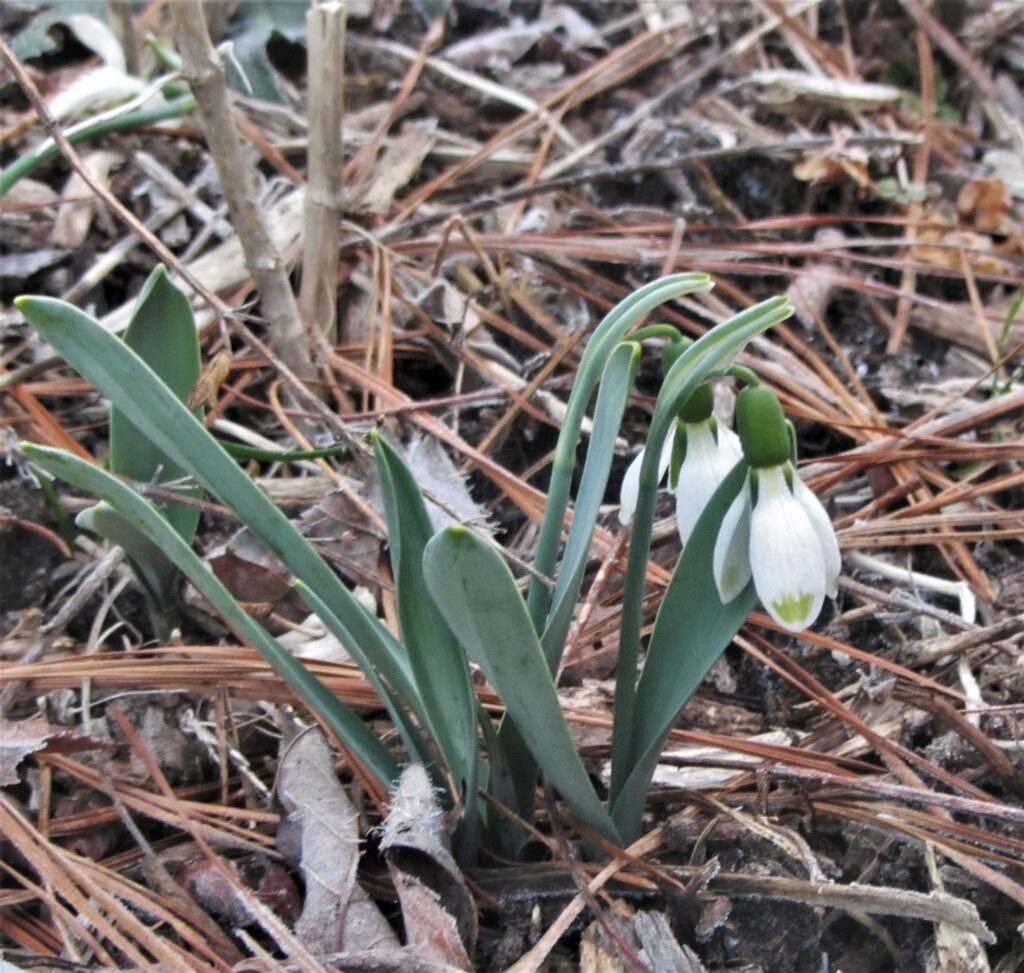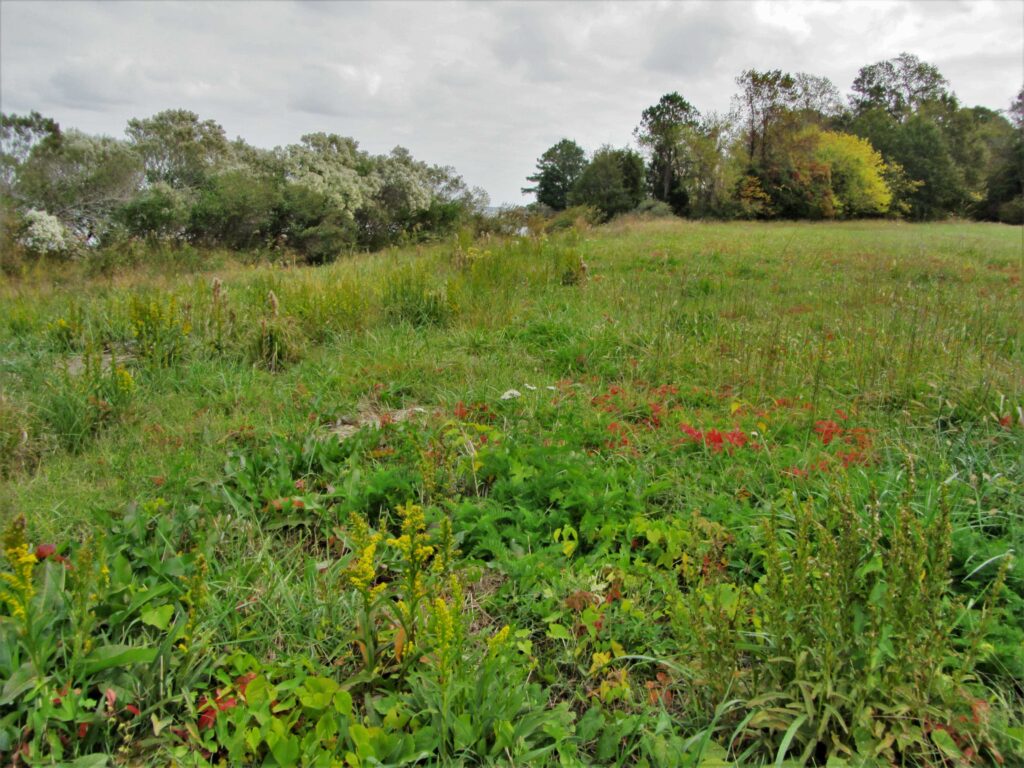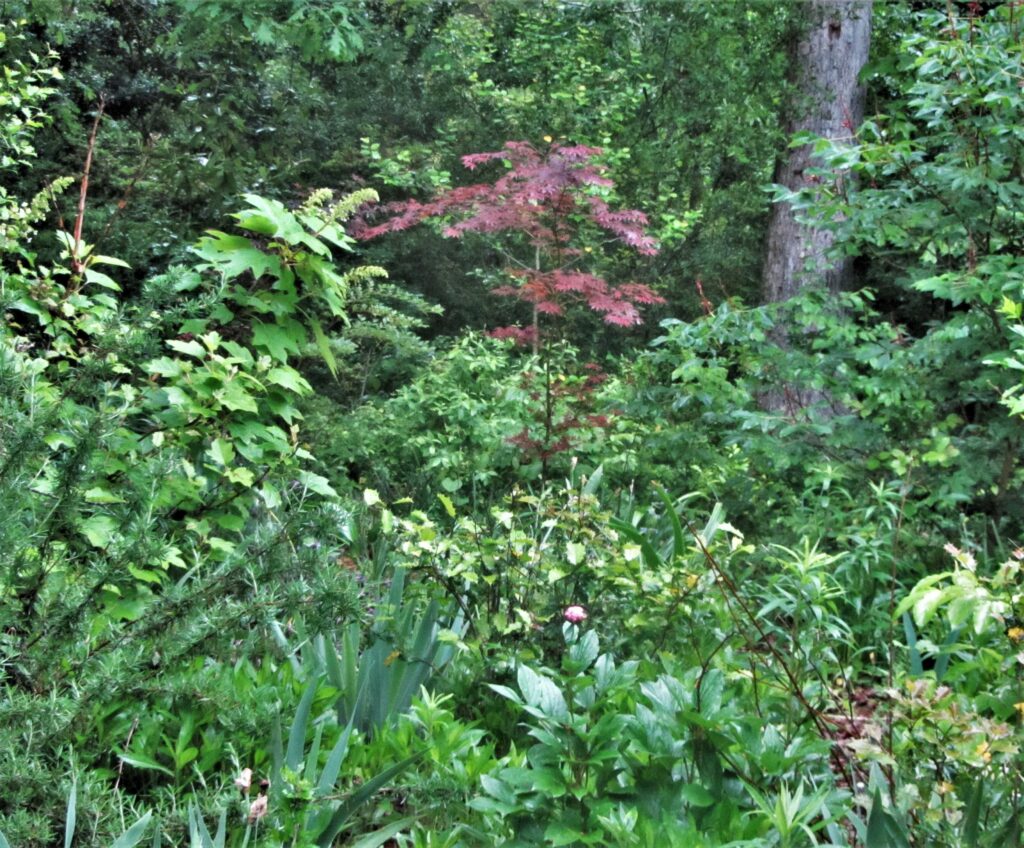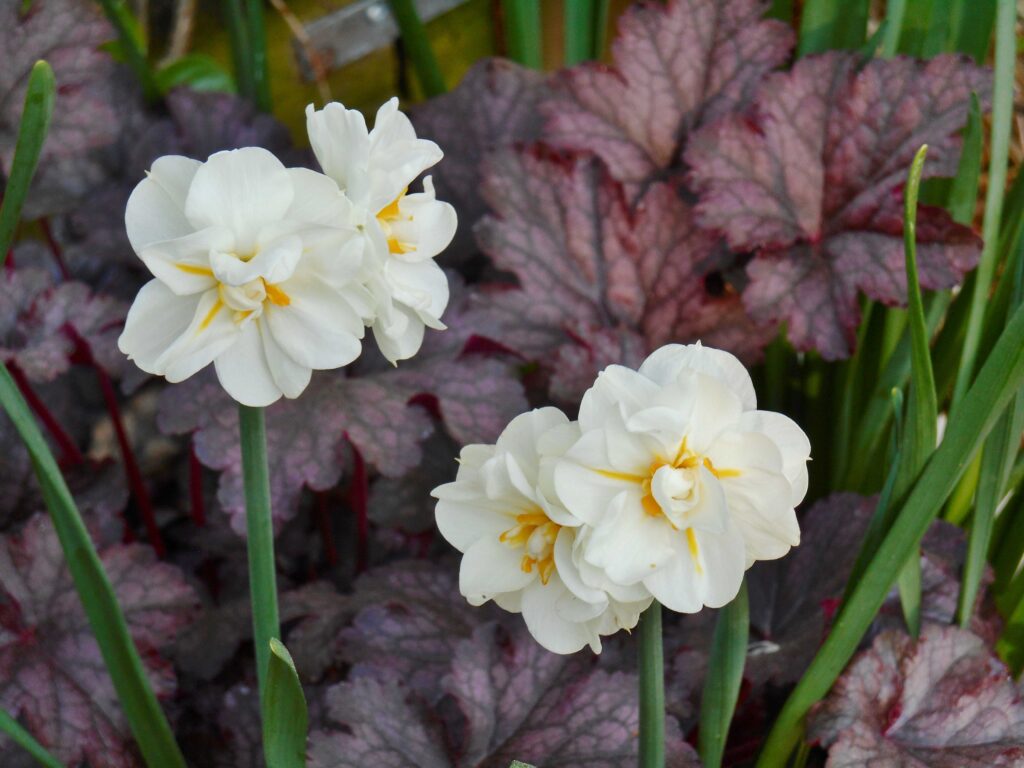Making a Resilient Drought-Tolerant Garden Part II: Techniques and Strategies
Enthusiastic gardeners begin planning, planting, and preparing for the season to come at the first hint of spring. Some of us may still be planting daffodils in December or January and watch for the first snowdrops to appear as the last bulbs go into the ground. There is very little break during winter. We are always watching the progress of our gardens and exploring sustainable gardening practices. And our hearts remain filled with hope for the seasons to come.
Our optimism has suffered some challenges and setbacks in recent years. The weather patterns we’ve been accustomed to for much of our lives are shifting. We’re experiencing the extremes of hot and cold, flooding and drought. These extremes stress marginal plants in our gardens even more than they create stress for the gardener! How many of us have taken inventory of plants lost to unusually cold during the winter, too much summer heat, and unexpectedly dry weather?
Together, we’re learning how to adapt to volatile weather patterns fueled by greenhouse gasses in the atmosphere and warming oceans. We find stories of record heat, record cold, flooding, wildfires, and drought in the news each day. We can’t change the weather, but we can make small changes to improve our sustainable gardening practices and make our plantings more resilient.
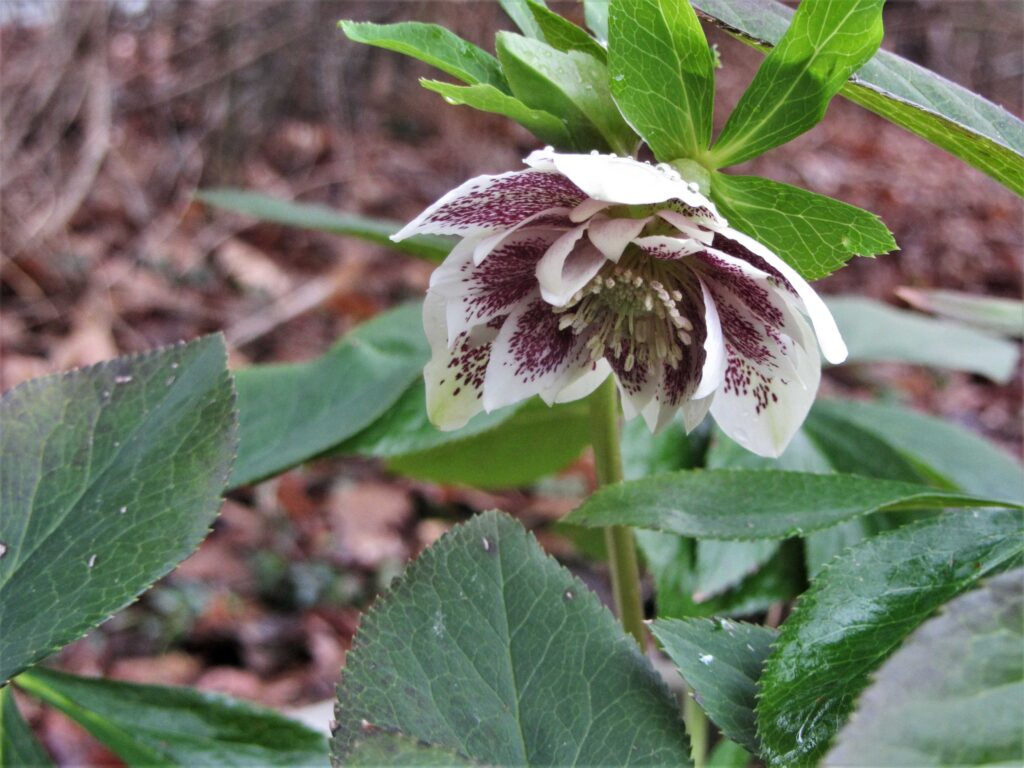
Helleborus hybrids, native to Europe, thrive in dry shade, one of the hardest areas to plant. They remain evergreen, with tough, leathery leaves that persist from one winter to the next. Most bloom between December and May, supporting a wide variety of pollinators. They and spread into a functional ground cover in just a few years.
Growing drought tolerant plants greatly reduces the need to irrigate to keep a garden looking good through dry spells. Water for agriculture and horticulture grows scarcer as demands for clean water increase. Rapidly developing areas, like ours, are already imposing outdoor water use restrictions as they look at the challenges of growing demand and limited supplies.
Making a Resilient Drought-Tolerant Garden Part I: Right Plant, Right Place
We can explore how communities in less-developed areas use water in their gardens and learn from their experiences and successes. Without municipal water systems, drip irrigation technology, and seemingly unlimited supplies of water at the turn of a tap, they still manage to care for their gardens.
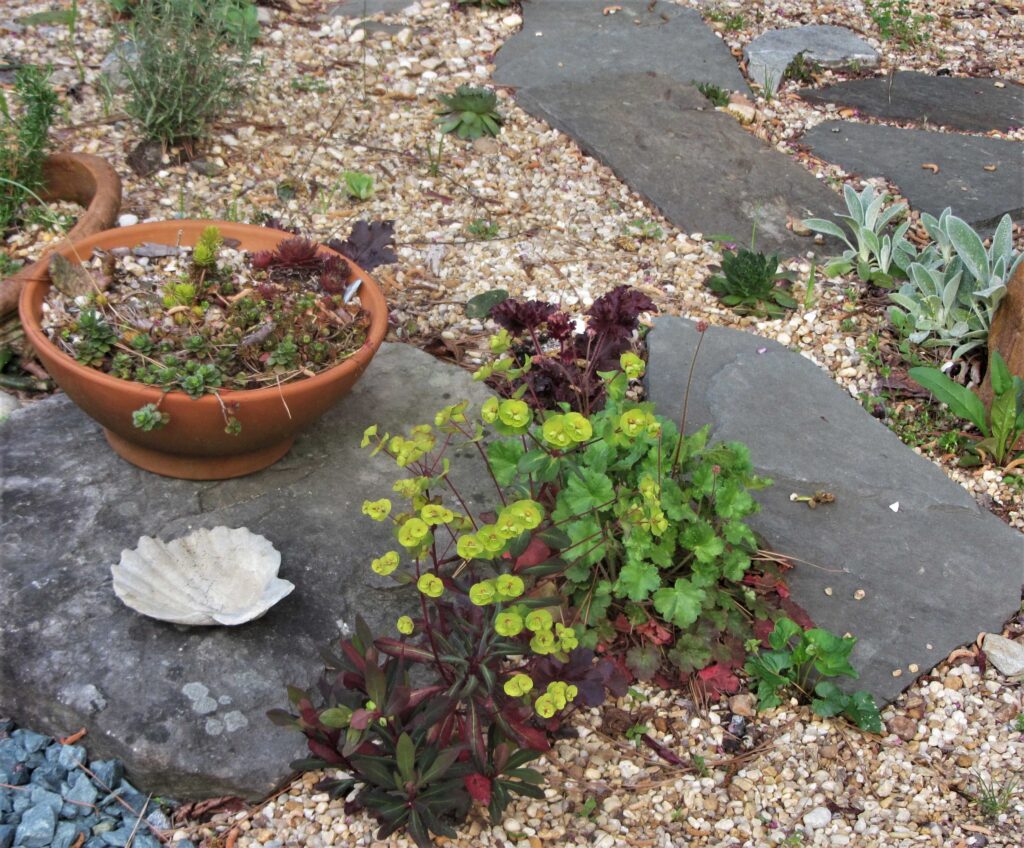
Succulent Eurphorbia, Echeveria and Sedums, and velvet leaved Stachys byzantina, all have adaptations that allow them to thrive in dry gardens. Large stones and gravel mulch further conserve water in the soil, providing moist pockets of soil for root growth while reducing evaporation. Williamsburg Botanical Garden and Freedom Park Arboretum April 2022
David Bainbridge, author of Gardening with Less Water; Low-Tech, Low-Cost, Techniques; Use Up to 90% Less Water in Your Garden, describes many of these low-tech methods in detail. Bainbridge began his research into efficient irrigation with the Dry Lands Research Institute at the University of California during the 1980s. He has researched ancient agricultural techniques and worked with various agricultural projects in desert and drought-stricken areas.
Adapting some of these techniques for use in our own gardens helps us conserve municipal water while it is still plentiful. Drought-tolerant gardening strategies can help us enjoy beautiful, abundant gardens throughout the year with little or no supplemental watering. Our gardens can still look lush and green- or silver- while lawns down the street turn brown.
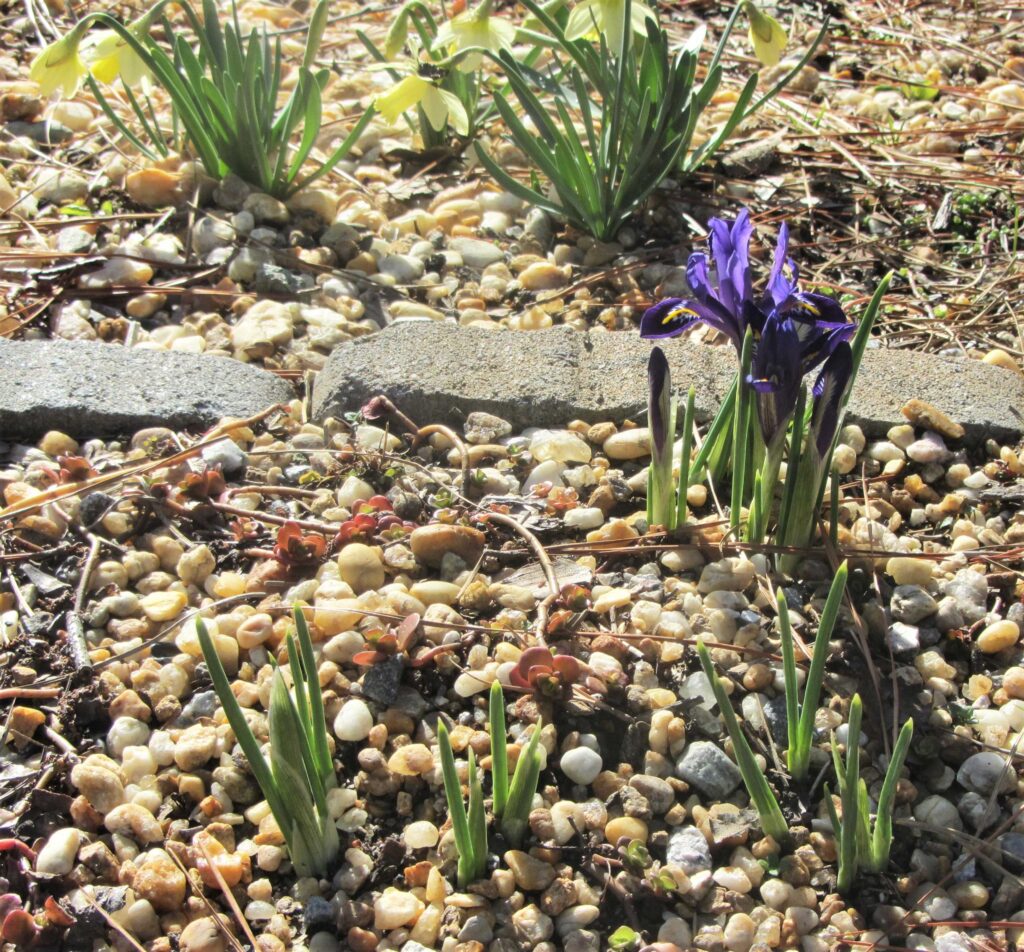
Iris reticulata, which grow from small bulbs, want moisture in winter and dry soil during the summer. They grow here with Sedums and miniature Narcissus. Williamsburg Botanical Garden and Freedom Park Arboretum February 2022.
There are a variety of strategies to assist plants in making the most of available moisture:
Site and Space Plants According to the Grower’s Recommendations
Crowding plants to get a lush look right away forces plants to compete for moisture. Proper spacing allows the root system of each plant the room it needs to develop and to support the plant’s canopy. Read the tag carefully, or consult a reputable source, to learn how tall and wide a plant can grow in our area, and its cultural requirements. Plants may mature to larger or smaller sizes depending on the resources available to them. It may take several years for some woody plants and perennials to reach their full potential. Don’t be tempted to crowd them when they are young.
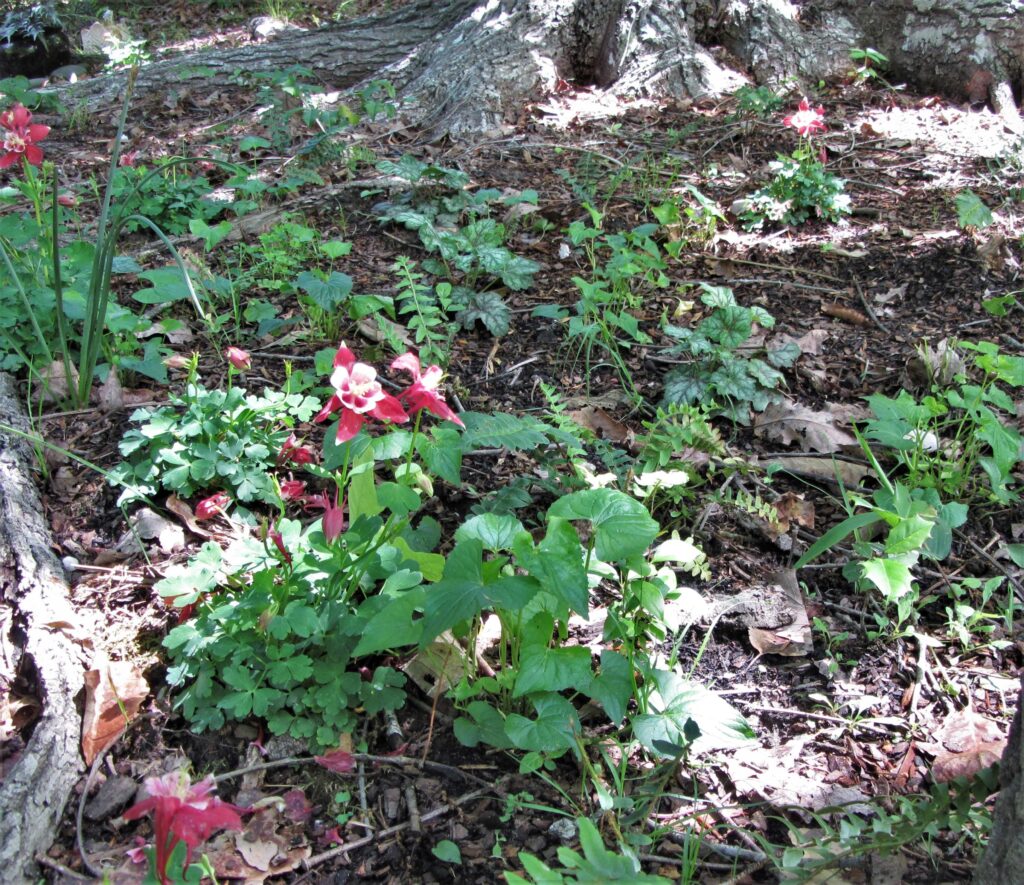
Space plants according to instructions on the tag. The planting will look sparse in the beginning, but will allow each plant the resources it needs to mature.
Site plants carefully so they receive the optimum amount of light without getting too much or too little. Plants will experience stress, and need more water to remain hydrated, when planted in too much direct sunlight. Notice where soil dries out quickly and where it retains moisture in your garden areas. Use drought tolerant plants in those areas where soil gets little rain or dries out quickly.
Mix deep rooted plants among more shallow rooted plants. Just as you vary the heights of plants strategically within a planting, give the same consideration to the root systems of plants within a grouping. You can also mix annuals among longer lived perennials during the first season or two as the perennials establish.
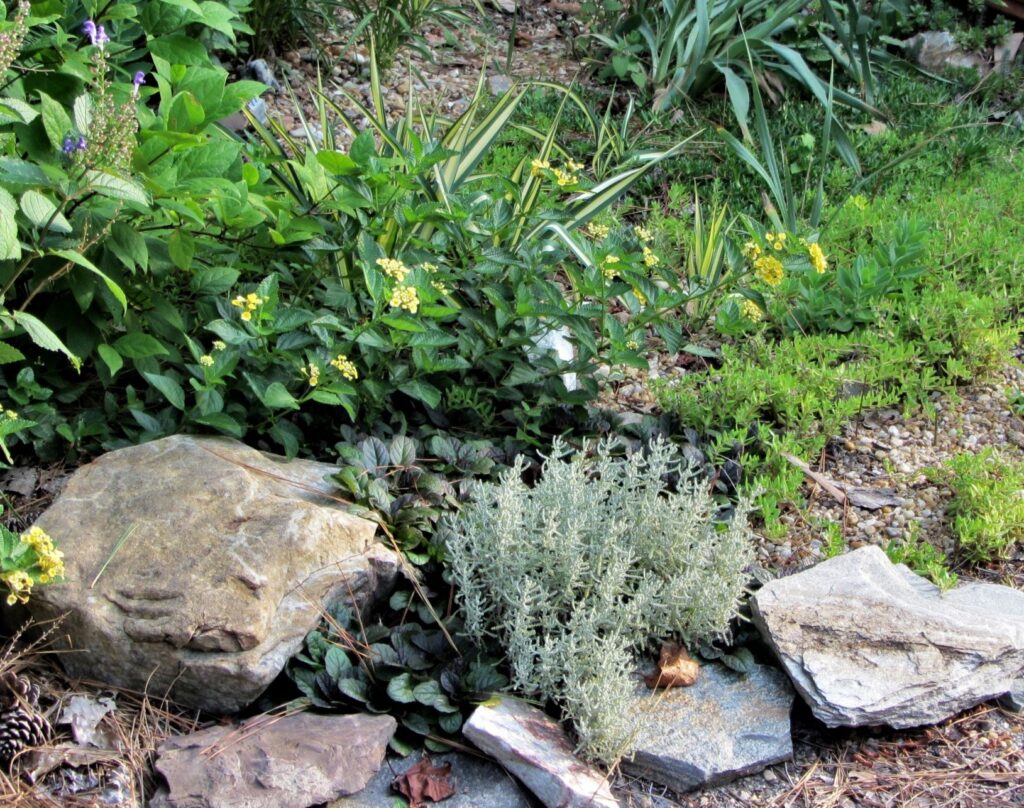
Santolina performs particularly well in a sunny rock garden where gravel mulch reflects sunlight while it keeps the soil moist and cool. Plants native to arid areas may develop mold and mildew if their foliage remains wet for too long. Gravel mulch helps prevent some microbial diseases from spreading and infecting plants. WBG-FPA 2022.
Mulch Wisely
Keep the soil covered with living plant material, with hardscape, or with mulch to conserve water and reduce water evaporation. Sequestered carbon will also sublimate from a stored solid in the soil back into the atmosphere when the ground is left uncovered.
Rocks, gravel, and cement slabs retain water in the soil. Consider using gravel mulch, which allows all irrigation to pass freely into the soil, and then holds the moisture in the soil until it is used by the plants’ roots. Gravel also reflects sunlight, keeps the soil cool and the plant healthier.
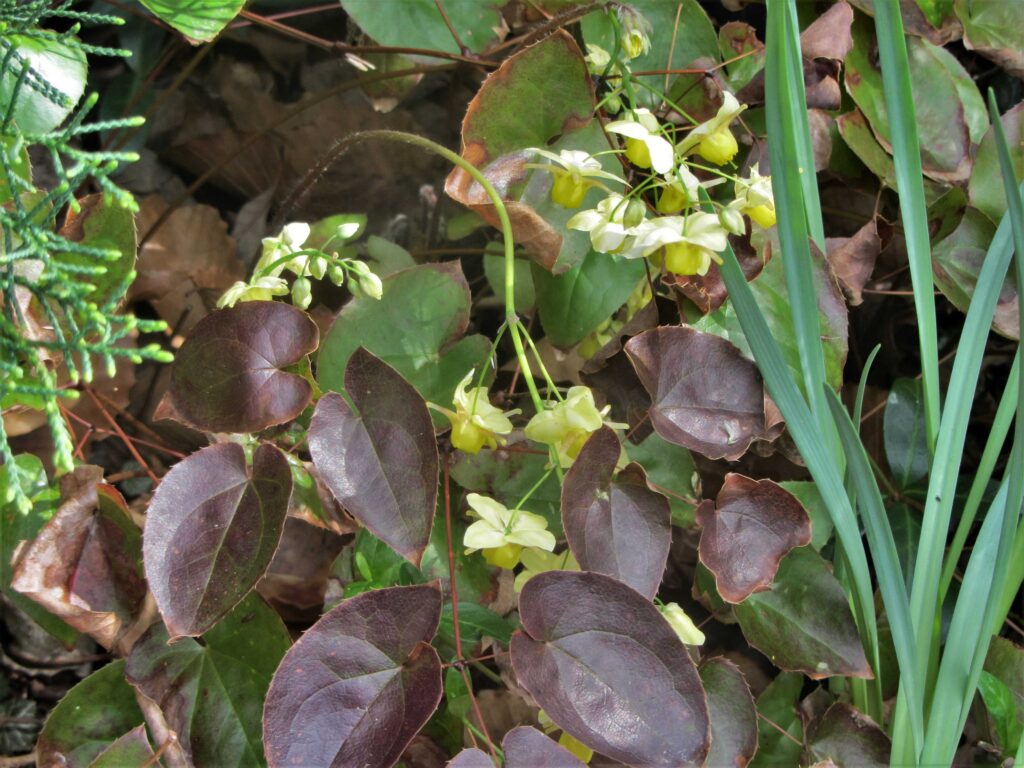
Epimedium, native to Asia and Southern Europe, has leathery leaves that allow it to thrive as a living ground cover in dry shade. Herbivores never touch it.
Sand Gardens
Peter Korn, a horticulture professional is Sweden, has been experimenting with planting in sand in his Zone 7a garden and commercial nursery. He has built raised beds of sand and rock over his alkaline soil. He is also experimenting with raised beds filled with sand and different substrates, instead of soil, for use in commercial roof-garden installations.
Korn is a pioneer in growing on sand to conserve water, while growing stronger and healthier plants with more resistance to pests and disease. Because they are grown lean, the plants require less weeding and staking. Hot sand discourages the germination of weed seeds in summer, while retaining moisture below the surface. His sand beds don’t require irrigation after plants are installed and watered-in. Sand, gravel, pumice, biochar, and other similar materials all make a water-retentive mulch on planting beds and in containers.
Placing a large rock, slab, or container near a plant helps conserve soil moisture for that plant’s roots. Planting beside a wall, even a low border of blocks, can offer the same moisture retaining benefit while shading the soil. Plants growing near landscaping blocks, walls, stepping stones, and even containers grow their roots into these protected areas where they readily find moist soil.

Fallen leaves enrich the soil below trees and shrubs while providing habitat for many invertebrates and microbial life. Wood chips, the ground remains of arborists’ work, perform many of the same functions. WBG – FPA 2020.
Organic Mulches
Most of us learned to prefer organic mulches that will decay and enrich the soil. Leaves, pine tags, and wood chips are all good choices. We’ve also read recommendations to use materials like newspaper, brown paper, and cardboard as mulch. There are some problems with these standard recommendations, according to Dr. Linda Chalker-Scott, an Associate Professor of Horticulture and Extension Specialist at Washington State University, and author of The Informed Gardener and How Plants Work.
Bark mulches can harbor harmful insects like termites and may repel water and absorb rain and irrigation before the water can penetrate the soil to the roots of desirable plants. Bark has natural coatings that help repel rain from tree trunks and limbs. Cardboard and newsprint may also harbor termites or other less desirable insects and will also repel water when they become dried out. Once re-wetted, they hold water at the surface instead of directing irrigation into the soil to reach plant roots. If you mulch with manufactured paper materials, leave spaces for water to penetrate around them, and use them under a layer of other materials so they don’t dry out or blow away before they decompose.
Some gardeners find that rodents, including moles and voles, find safe and satisfying nesting areas under these protective bark and paper mulches. Voles will tunnel under mulch to attack the stems of shrubs and sapling trees.
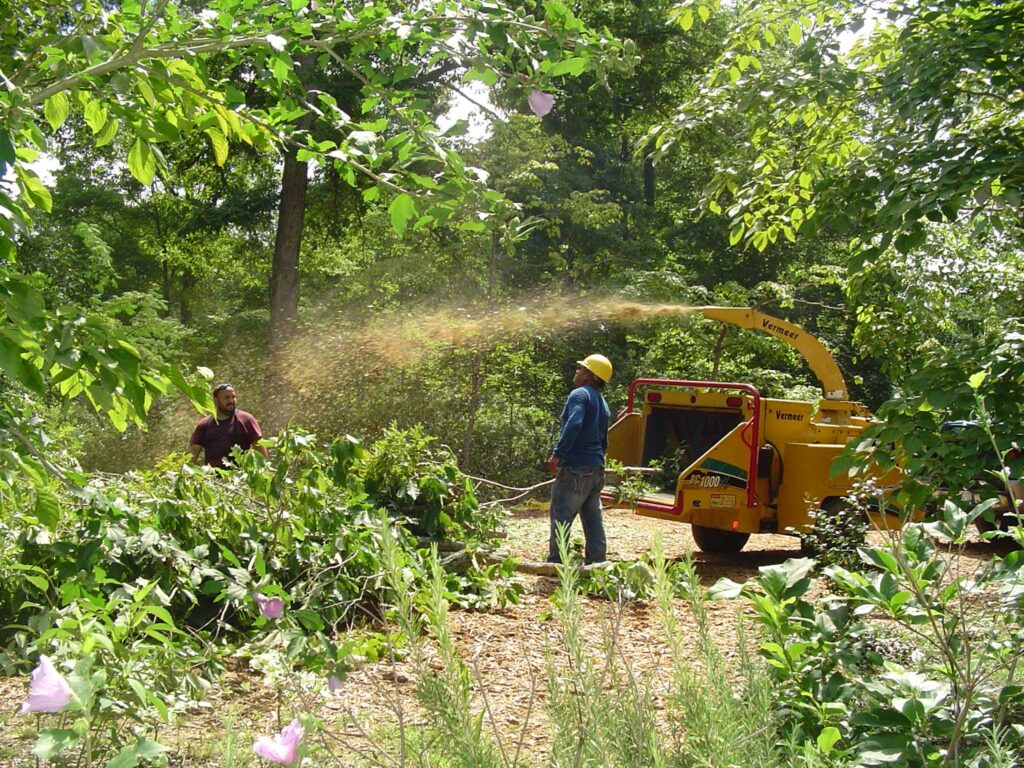
Wood chips make an excellent mulch to preserve moisture in the soil. This mulch decomposes slowly and is rarely contaminated with pesticides or industrial chemicals. Native shrubs and trees often grow from seeds dropped into wood chip mulch by squirrels and birds. July 2013, author’s garden after a summer thunderstorm and possible tornado toppled several mature trees.
Also consider the industrial chemicals in paper and ink, the slick coatings on cardboard, and other additives that will decompose into your garden soil. These may include heavy metals. If you use these materials, remove all tape and printing from cardboard, and cut cardboard into smaller pieces. Shred paper. Avoid using paper printed with colorful inks where edible plants are grown, because of the chemicals in the ink.
Dr. Chalker-Scott also cautions that commercial compost may still harbor pesticides used on the plants that went into its production. Even grass clippings may be contaminated with chemicals used on lawns. Commercial compost may also contain lead and other heavy metals. The U.S. Composting Council has a Seal of Testing Assurance program for compost manufacturers who regularly test their products for safety. Dr. Chalker-Scott recommends ground wood chips, available from arborists, as a safe and useful organic mulch. Wood chips don’t repel water as much as chunks of bark repel water, and they add a variety of nutrients to the soil as they decompose.
Keep in mind that mulches which decompose into humus-rich soil will also provide spaces for weed seeds to prosper. Weeds use water that would otherwise be available to cultivated plants. How often have you seen weeds growing in organic mulch placed over landscaping fabric? The weed seeds come on the breeze, or with birds and other small animals, and take every opportunity to grow.
Ollas and Clay Pots
Gardeners in some arid areas sink a porous clay pot into the ground near a young tree or grouping of plants. They fill the pot, or olla, and allow the water to wick into the soil as it is needed. These pots may have small mouths, or the opening may be covered with a saucer. The pot doesn’t need to have a drainage hole because water wicks through the unglazed walls into the soil as roots require more water. The water goes directly to the root zone, where it is needed, which reduces evaporation from irrigation.
A buried clay chimney flue provides water even deeper into the ground. To experiment with this, bury a pot, 8”-10” tall, into a garden bed near a new planting. Leave the rim of the pot exposed at ground level. Put a rock over any drainage hole in the bottom so the water doesn’t just immediately run out. Fill the pot with water and cover the top to reduce evaporation. If you leave the top open, you may find toads enjoying the accommodations. Re-fill the pot as needed.

Use hardscape to catch and re-direct stormwater run-off. These simple terraces slow the flow of water down the slope so that it can sink in and make this area of dry shade a functional area to grow a variety of ferns. This area is mulched in pea gravel and the ferns are now growing in to form a continuous ground cover. April 2021.
Direct Stormwater with Hardscaping
Use infrastructure to direct stormwater run-off into a planting area. This might include French drains, pipes carrying water from downspouts, or even hardscape that channels water to where it is needed. Consider installing a rain garden where water can slowly percolate into the soil, instead of running off into a storm drain, ravine, or into the street.
Water diverted to a rain barrel or holding tank stores rainwater for future irrigation. Rain contains small amounts of nitrogen from the atmosphere which helps plants grow. More importantly, rain doesn’t contain the chemicals added to municipal water systems, which may not be helpful to growing plants.
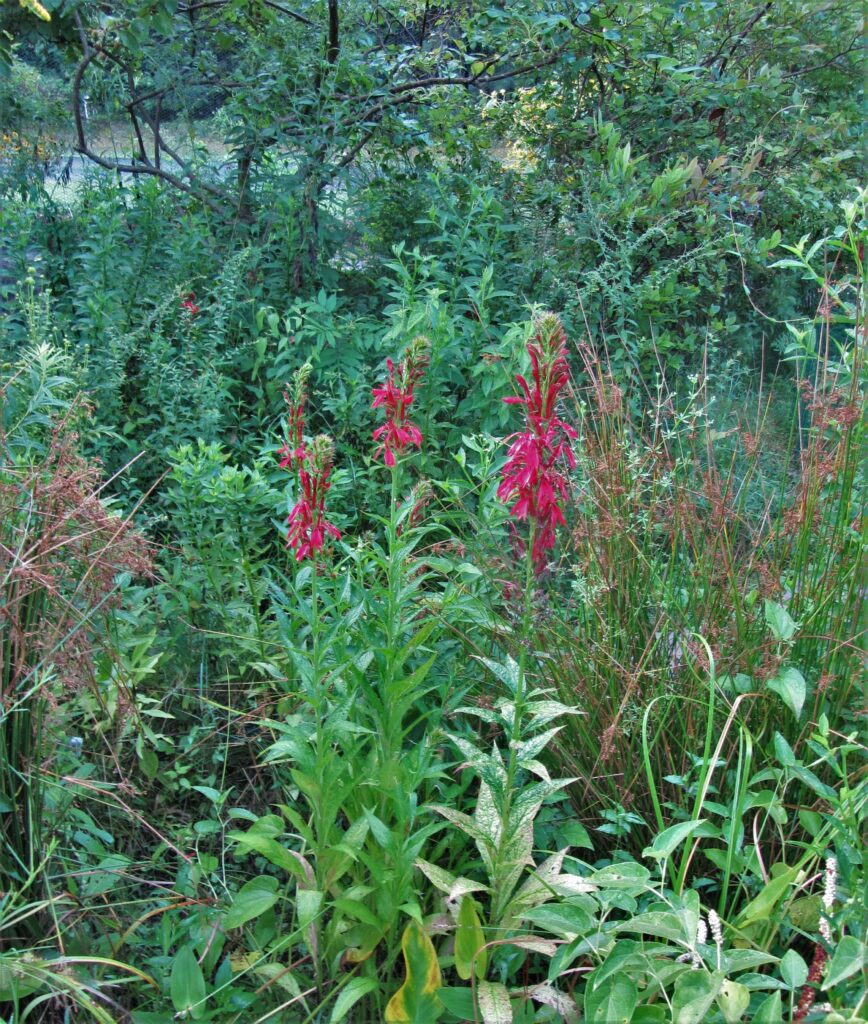
Cardinal flower, Lobelia cardinalis, blooms in August 2021 in a wetlands area designed to catch and hold stormwater run-off at the Williamsburg Botanical Garden. Cardinal flower prefers consistently moist, acidic soils. This area is planted exclusively with indigenous plants.
Work with the Seasons
Geophytes take advantage of seasonal opportunities for growth. Choose geophytes that grow and bloom during the periods when more moisture is available. These plants can remain dormant during the drier parts of the year.
Spring flowering bulbs grow and bloom when the soil is moist in late winter and early spring. They are dying back and entering their dormant period before our summers heat up in June. Most of these European and Middle Eastern geophyte species prefer dry soil while they are dormant, and some species may rot if the soil stays too wet.

Lycoris radiata bloom from bulbs in late summer and early fall after a heavy rain. Leaves follow the fading flowers and persist into early spring. Bulbs divide year to year as each patch expands.
Other flowering bulbs, like Lycoris radiata, the hurricane lily, wait to bloom until after a heavy rain in late summer. Their leaves grow through the fall and winter before the bulb goes dormant in the spring. Summer blooming members of the Amaryllis family, like Crinum and x Amarcrinum hybrid lilies have very long bulbs and deep roots to take advantage of deeper moisture.
Fall planting helps many plants to grow new roots during cool, wet weather before new growth begins in spring. Woody plants and many perennials survive the stress of their first summer more easily if they had a chance to get established during the cooler months. Planting a dormant plant allows it to grow new roots before supporting new stems, leaves, and flowers the following summer.
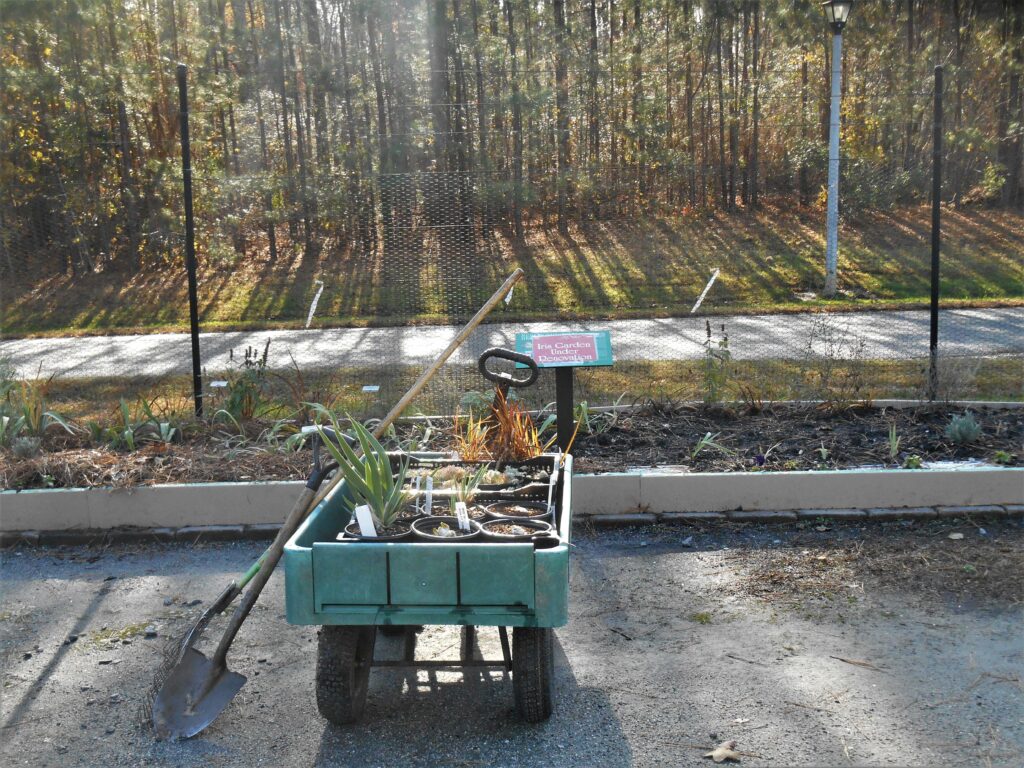
November is an excellent time to plant new perennials, trees and shrubs. They will be established and ready to grow the following spring. WBG-FPA Iris Border, November 2018.
First-Aid
Help new plants get established during their first year while they are vulnerable to every environmental stress. Water in new plantings so the root ball settles into the planting hole without gaps, and so the roots begin their new life well-hydrated. Add 2”-3” inches of mulch over their root balls at planting. But keep the mulch away from touching their stems to keep the stems healthy.
Irrigation may be required during dry spells while roots grow into the surrounding soil. Even drought tolerant plants will need regular irrigation during dry weather until their root system develops. Tender new plants may also need some shade from direct sunlight during their first season.
Once a plant’s root system has grown deep and wide, avoid moving the plant. Digging and moving damages the root system. Plants with tap roots may take several years to recover after a move, if they even survive. More shallow rooted plants, and perennials with multiple crowns, can be lifted and divided as needed. Follow recommendations for the timing of digging, related to each plant’s growth cycle. Divisions should be given ‘first-aid’ once again until they establish.
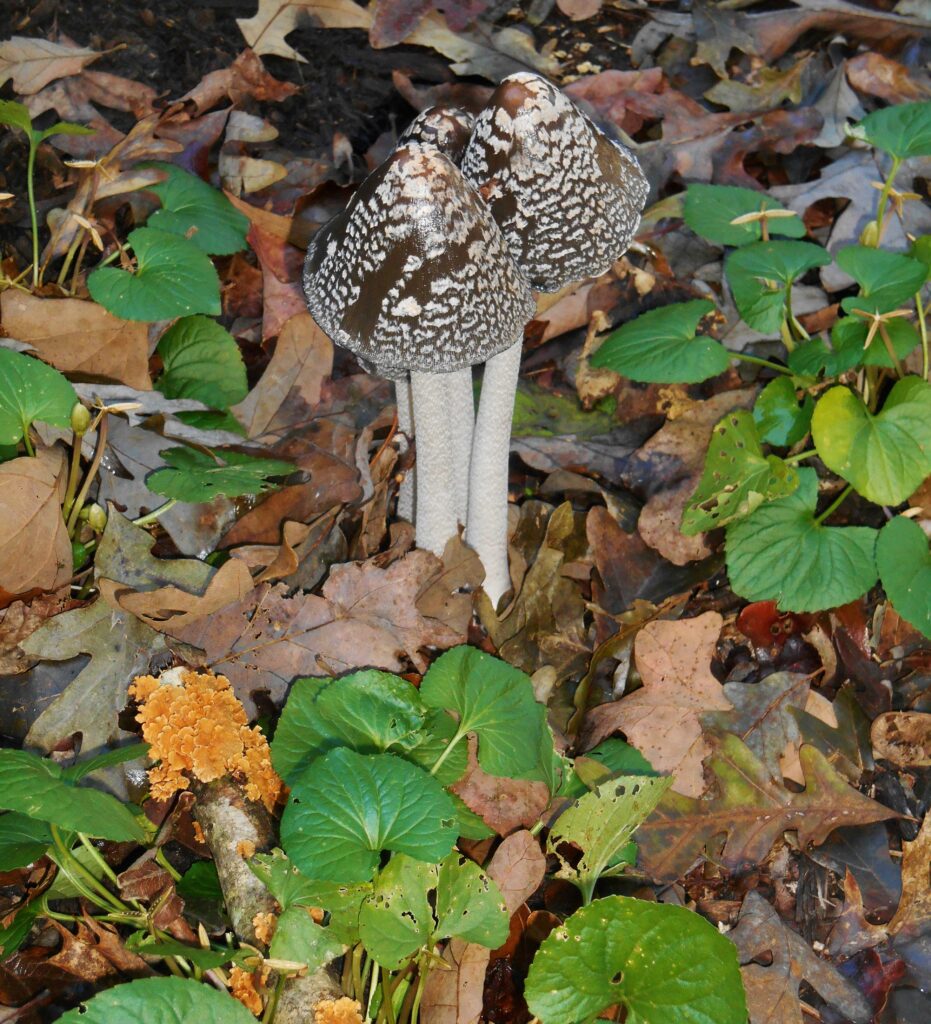
Mycorrhizal fungi are an important part of the underground community that support plants. Their networks connect the roots of plants over long distances, distributing food and chemical communications. Fungi are an indicator of healthy, living soil.
Plant Communities
Observing plants growing wild in nature shows us that they usually grow together in groups. Even groups of several different types help each other. Taller plants shade smaller ones. Ground covers protect the soil and conserve moisture. When designing a planting, keep in mind that grouping individuals with similar needs together makes caring for them more efficient. Designers generally recommend planting drifts of several plants of the same species together for greater impact.
A newer design method is ‘matrix planting.’ Plants may appear more scattered, but there is an overall repeating pattern of a limited palette of plants to achieve a meadow-like effect. The planting is usually tied together visually with lots of individual smaller ground cover plants, often an ornamental grass, that remain attractive throughout the year. This is the ‘background’ or the constant feature of the planting. A variety of bulbs, annuals, and perennials come into prominence seasonally through the groundcover, and later fade. Using drought tolerant plants that grow well together can eliminate the need to irrigate such a planting after the first year. Flowering pollinator friendly plants really shine in this planting style.
Creating garden layers, both above and below ground, is an excellent way to make the most of available resources while providing abundant habitat for wildlife.
Native, or Not?
We often hear that native plants are the most resilient and drought tolerant choices for our gardens. Like most simplistic advice, that claim requires careful consideration. Native plants developed over thousands of years to prosper in their specialized environments. How well will they perform in the very altered environment of our residential gardens?
As we explore the rich biodiversity of native North American flora, and particularly those plants indigenous to coastal Virginia, we discover many beautiful and functional species crucial to support our Eastern Temperate Forest ecosystem. Many of these species have very specific needs for soil chemistry and texture, moisture, sunlight, and supporting plants that typically grow in the same area near them. Unless we can give them the growing conditions they require, we may end up killing the very plants we want to conserve.
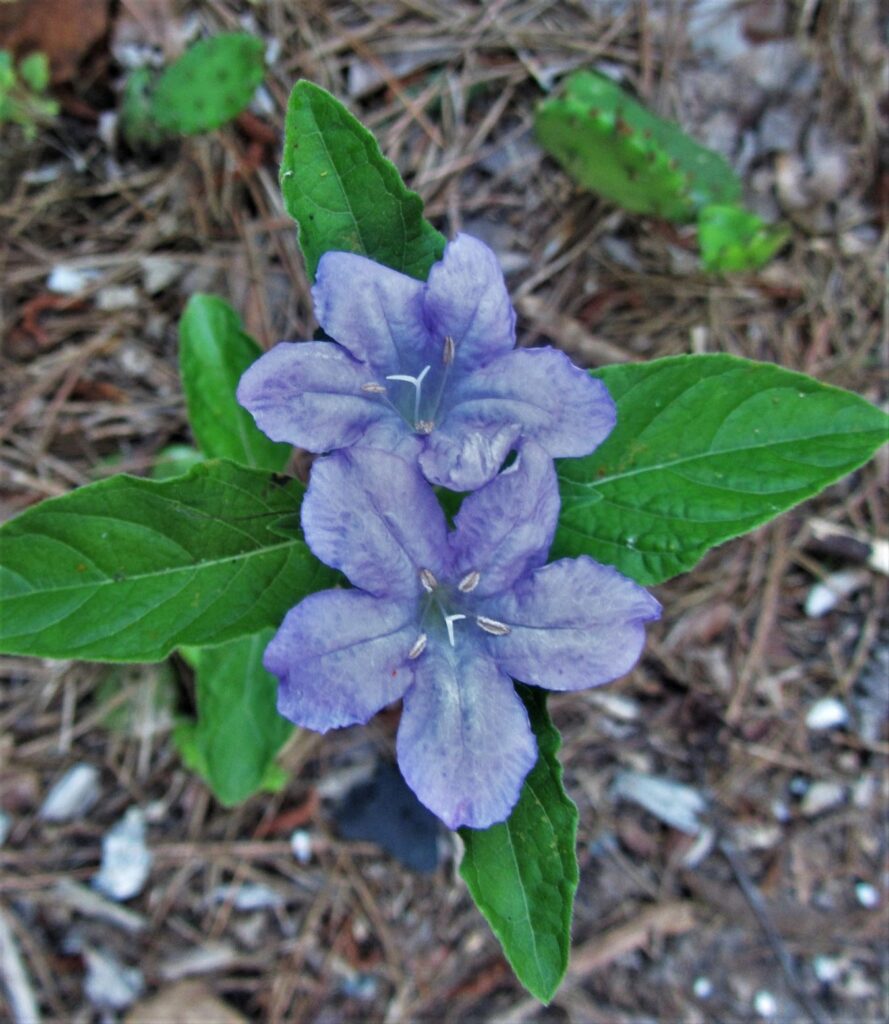
Ruella caroliniensis, Wild Petunia, is a host plant for the common buckeye butterfly. This native ephemeral has specific needs that must be met for it to establish.
The Only Constant is Continuous Change
As our weather patterns change, we find that our summers grow too hot for some indigenous species to thrive. Others need more or less rainfall than we currently get each year. Native soils may have been scraped away as our homes were built, native forests cleared, and nearby streams and creeks dammed up or paved over. We have changed the growing conditions in critical ways and so we can’t assume that any indigenous species will continue to thrive where we plant it. It is always smart to learn about a plant’s needs first, and then decide whether we can meet those needs in our situation.
A little research into a species may reveal that the plant is native to mountainous regions, at altitude, and not in our muggy, coastal region. Or native plants may be indigenous to the prairie several states away and have the rangy growth habit of plants that grow among tall grasses. Some natives are ephemerals, blooming and gone in just a few months while others spread aggressively by scattering seeds and expanding with stolons or rhizomes. These are things we need to know before introducing even native plants into our yards.

This small Southern live oak, Q. virginiana, planted bare root, requires protection from grazing deer. It has been repeatedly grazed over the years, stunting its growth.
Native Flora, Native Fauna
Even if a native plant will thrive in our yard, we may find it grazed by an indigenous deer, rabbit, or vole. The buttonbush, Cephalanthus occidentalis, I’ve nurtured for the past several years was badly grazed this week. Grazing deer present a serious threat to our native wildflowers and trees. Animals seek out moisture when the weather is dry and may eat plants they would normally ignore, simply to get the water in their leaves.
Native trees make the greatest contribution to restoring our ecosystems because of the vast number of animal, insect, and microbial species they support. They are our keystone species, and many of them tolerate a wide range of conditions. Planting native trees can make it possible to grow other native species in community with them. Trees improve the soil and most prove very drought tolerant once established. Protect young trees from deer rubbing and grazing.
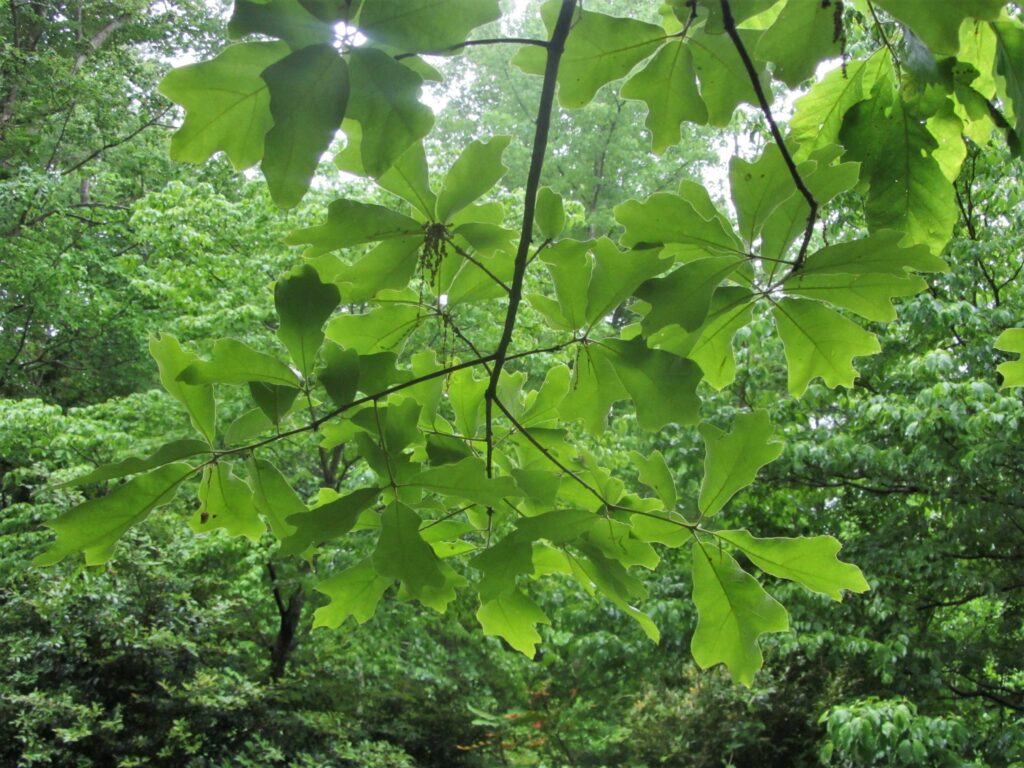
Native oak, probably Q. marilandica, generously sown by a squirrel as our front garden recovered after the storm.
Plants native to Europe, Africa, Asia, the Middle East, and the Pacific Islands may perform as well or even better than indigenous plants in our residential landscapes. Many of these imported plants come from arid areas and are drought tolerant. The same design features that help them use and lose less water, like textured, fragrant, or leathery leaves, also make them less attractive to herbivores. The motto ‘Right plant, right place’ should guide us in choosing plants for sustainable, low-input gardens.
Opportunities for Growth
Sometimes the rules of the gardening game change and old solutions no longer solve current problems. Extreme weather events can destroy years of investment and effort. But these challenges also present opportunities to try something new. Let’s find the opportunity in every challenge and learn from horticultural professionals who are showing us new ways to make the most of the resources available to us.
All Photos by Elizabeth McCoy
For More Information:
Making a Resilient Drought-Tolerant Garden Part I: Right Plant, Right Place
Bainbridge, David A. Gardening with Less Water; Low-Tech, Low-Cost, Techniques; Use Up to 90% Less Water in Your Garden. Storey Publishing. 2015.
Bruce, Jonny. (2023 June). True grit. Gardens Illustrated. pg. 40-49.
Chalker-Scott, Linda. The Informed Gardener. University of Washington Press. 2008.
Ogden, Lauren Springer and Scott Ogden. Waterwise Plants for Sustainable Gardens: 200 Drought-Tolerant Choices for All Climates. Timber Press. 2011.
Sherry, Danielle. (2023 July-August). Water-Wise Design Ideas. Fine Gardening Magazine. pg. 65-72.

